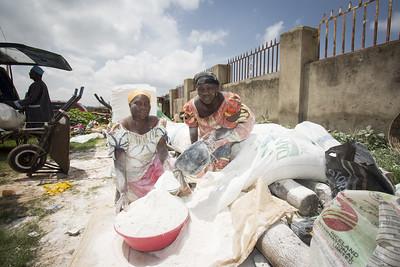Dossiers
The Russia-Ukraine War: What will happen to food prices, and what can we learn from prior shocks?
Read here about the effects of the Russian-Ukrainian war on commodity prices (wheat and fertiliser) and policy implications for countries in North and sub-Saharan Africa and the Middle East
Éditeur SPARC
In the five weeks since Russia invaded Ukraine, commodity markets have been rocked, as both economies have effectively been removed from global trade. Ukrainian exports have virtually stopped. Daily sanctions on Russia are further pressuring markets. Major grain dealers, such as Bunge and ADM, have closed their facilities in the region, and Maersk, amongst other shipping companies, has suspended service to Russian ports.
These dramatic and quick shifts in trade will acutely impact many developing countries, including in North and sub-Saharan Africa and the Middle East, where many people struggle to afford their food.
Rising wheat and fertiliser prices
Wheat and fertiliser availability are having the greatest impact on food price changes. Ukraine and Russia produce 14% of the world’s wheat and account for over 30% of the export market (Croix Rouge, 2022). Wheat prices reached $12.45/bushel on 7 March, the highest price since 2008.
Russia produces 20% of the world’s potash, and Ukraine is also a major exporter of fertilisers, notably urea (NRCAN, 2022). Already-high prices have spiked even higher. Potash had almost doubled in price, to $392/mt, from January to the end of February (World Bank Commodity Price Data, 2022).
Impact on countries in North and sub-Saharan Africa and the Middle East
Countries across North and sub-Saharan Africa and the Middle East will feel the effects. For example, Mali, South Sudan, Sudan and Uganda all abstained from condemning Russia’s invasion in the UN General Assembly, a sign – in part – of close economic and military ties.
Some African countries rely on Ukraine and Russia for both cereal and fertiliser imports:
- Ukraine exported $2.9 billion worth of agricultural products to Africa in 2020: 48% was wheat, 31% maize.
- Cereal imports from Russia and Ukraine account for over 60% of Egypt's total cereal imports, 46% for Tunisia and 17% for Morocco.
- Wheat accounts for one quarter of all cereal consumption in Nigeria. In 2020, over $400 million was imported from Russia (COMTRADE, 2022).
- Kenya’s agriculture ministry is currently designing targeted fertiliser subsidies, anticipating a price shock in Russian potash, exported through Ukraine.
People affected by failed rains now face higher food prices
Extreme weather across Africa is complicating the fragile market place. East Africa faces a series of failed rains (SPARC, 2022). A combination of dry conditions and protracted conflicts means the number of people facing extreme hunger has grown from 3.6 million to 10.5 million in West Africa (WFP, 2022). The United Nations General Assembly noted on 7 March that the conflict Ukraine is having an immediate negative impact on the poor, exacerbating existing vulnerabilities and increasing food insecurity (UN, 2022, Statement from the Under-Secretary General for Humanitarian Affaires).
In response, we can draw lessons from previous food-price crises:
- Make a measured response. Food security in much of the Middle East and sub-Saharan African is frequently under duress due to multiple pressures – droughts, floods and conflict. Longer-term climate shifts are increasingly impacting food availability. Still, the capacity of farmers and pastoralists to adapt is notable. Moreover, for much of sub-Saharan Africa, the price of wheat has only a limited impact on low-income farmers, as it is not a staple. Alternatives, such as maize, millet and cassava, are available.
- Work to stabilise markets. Governments can learn from the food price crises of 2008–2013, when several African states put in place insulating policy measures. These included efforts to control food prices, as well as trade policies (World Bank, 2019). However, in some cases these were counterproductive, as they raised volatility in domestic markets. The United Nations is currently encouraging wheat-producing countries to up exports in search of near-term price stability. Policy options vary, but an immediate analysis domestic options need to be balanced with international interventions.
- Support targeted social protection schemes and keep them nimble. Targeted subsidies for fertiliser will be important, as will be schemes that support greater diversification of cereal production. During the last food-price spike (2007–2008), the most-effective actions were those of governments, aided by donors, to support farmers to grow more through cheaper seeds, fertiliser, electricity to run irrigation pumps and so on. The result was a sharp rise in the global rate of cereal production, with much of it coming from Africa and Asia, where small farms predominate.
This is the time for international agencies to redouble efforts on food security. The problem is not only the war in Ukraine, but also a story of multiple, compounding challenges and how people adapt. By learning from prior experience, we can help navigate the volatile near future.
SPARC-Knowledge Supporting Pastoralism and Agriculture in Recurrent and Protracted Crises (SPARC) generates evidence and addresses knowledge gaps to build the resilience of millions of pastoralists, agro-pastoralists and farmers in pastoralist communities in sub-Saharan Africa and the Middle East.

Women sell cassava flour at market, Abuja, Nigeria
Credit Image by Milo Mitchell / IFPRI - CC BY-NC-ND 2.0